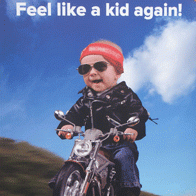Search the Community
Showing results for tags 'psi'.
-
Had my new Avon VenomX 150/90-16 80H installed today. My last one wore flat in the middle due to me running it with to much air pressure. Why did I run to much psi is beyond me. Call it a $145.00 mistake. 54 to 56 psi and it turned into a car tire...totally square. It started riding so bad that I thought my swingarm was worn out. Had swingarm checked while tire was off and no play at all...perfect. New mount and balance and the old girl tracks true as ever. Bring on the weather...we are ready to roll once again! Thinking about a Thanksgiving ride to Myrtle Beach tomorrow...gonna be a beautiful day here in South Carolina.
-
I had to replace my class controller and I was wondering if there was a way to change the display from psi to kg/cm???
- 8 replies
-
- class
- controller
-
(and 3 more)
Tagged with:
-
Had a Avon 130 on the front. Changed to a Michelin 2 on the front size 130 also. Put dyna beads in, took weights OFF rim. Now the handlebar shake from side to side and not up and down. Had put the livening links in and had to take them too and it helped. Running 45 psi rear shock, and 5 lbs in the forks, and 40 psi in the front tire. Bead is even all the way away around the tire and is turning in the right direction. What could be causing the tire to shake side to side? also adjusted steering head barring. tew47
-
Has anyone looked into replacing the oil pressure relief spring with one that would hold the oil pressure at a bit higher level than what is currently used or is this a bad idea all the way around for these bikes (RSV). I know when I was building Buick V6 engines a long time back I would increase the pressure by swapping out the relief spring for one slightly stronger which would run the idle pressure up a few pounds. This running at 8 - 10 psi is crazy only because by the time you see it's off the gauge it's way too late. I was thinking of somewhere around 20 - 25 psi would be nice and a top cruse pressure of around 40 psi hot.
-
I found out several months ago that the dial air pressure guage I had been using was giving an innaccurate pressure reading. It was showing a higher than actual reading. I purchased a good digital and corrected all my vehicles and trailer's pressures. Or so I thought. After reading a current thread about tire life and air pressures, I started to wonder if I had re-checked my bike's pressures. I usually check them monthly, but with my work travel schedule, time flys and things got off of schedule. I went out and checked them. The rear was at 24 PSI and the front at 22.5 PSI. So... I filled them to 40 PSI rear and 35 PSI front. Then I went for a ride WOW....... it rolled faster out of the garage. It cruised smoooooooothly down the road. Seemed to shift a little easier, turned nicer and just seemed like a different bike. The only down side seemed that the brakes were just a little less. Amazing how just a little air like 16 lbs in the rear and 11 lbs in the front can make such a difference. Next thing you will know is that if I fill the gas tank to the top the guage would show full... Lesson: Check you gauge against another one you know is accurate.
-
I don't think any air is getting to the shock. When try to set the air pressure on the class controller to medium for the rear shock the pump runs for a few seconds the display shows 43 psi. But when I turn off the key and then back on and check the rear pressure it shows 0 psi. If I try the high setting the pump runs until it shows 71 psi. but the bike does not raise. It all seems to be working fine with no errors. I would think that if the rear shock was bad it would not build pressure as quickly as it does. Any help would be great. Thanks.
-
Sunday morning I was on my way back from Key West when my wife and I stopped in Port St Lucie to eat lunch at The Cracker Barrell. All seemed well up to this point. I had been cruising along at about 70-80 mph for the better part of the morning. After we finished our lunch we got back on the bike and started pulling out of the parking lot. I noticed that the bike felt kinda squirlly, so I pulled over under a big oak tree in the back of the lot and got off to take a look at the rear tire. It was almost flat. The tire gage wouldn't even register!! I normally run about 42 psi in the rear tire. So, I get out the air compressor and get it to going. The tire pumps up to 50 psi(this is the max cold tire pressure on the side of the Avon Venom). I listen, can't hear a thing. We decide to give it a few minutes(maybe 5) and recheck. The pressure is down to 47 psi. I roll the bike back and forth looking for a nail or something but can't find anything. Hook up the compressor again and pump it up to 52 psi. We get on and go looking for a place to stay and maybe a place to get some help if needed. After stopping for gas along the interstate I check it again and the tire was still holding 54psi ( partly from heating up on the road). We take off again on the way home and stop in Daytona for the night. I check the tire again at the motel and it has 48 psi but it has also cooled down a little. I took it across the street and topped it off at 55 psi( taking into consideration that the tire is still a little warm). We go back to the motel and go to bed. This morning before we leave, I check the cold pressure and now it's at 47 psi, so after 10 hours and cooling down completely, I tell the missus "Let's go". We leave Daytona and ride from there home which is about 5 hours. When I checked again at home it has 51 psi in it. So, tomorow , off comes the tire for inspection and possible fix or replacement. The tire has less than 2500 miles of which 1440 were on this trip. Now for the question. What do you do as far as getting a tire replaced if, like this, it happens on a Sunday and all the shops are closed on Monday? Just stay in a motel until Tuesday?? A hole in a tire, I'm prepared to fix temporarily on the road. But what if the tire is beyond fixing?? I had the Venturerider list, but you know, I didn't the first time think of it!! Haven't looked to see if anyone was even near to where we were. Has anyone had any experience with the roadside assistance provided by Yamaha??
-
Now... I've got the parts I should replace (courtesy of Venturers tech page... hehe..) but I noticed a step I cannot do. On my YVR 90 I cannot seem to--with the CLASS control panel) reduce PSI to 0--of course on manual. It will at best decrease to 6, and even then the system pumps a extra psi in. Their another manual way? Or is it because I'm not really off the ground on the center stand?
-
After burning through the pirelli that came with my 2nd RSTD Im finally back on the CT. This time was the first time I had taken the tire off of the bike. It was surprisingly simple to do. Took it to my normal guy and it popped in at 50 psi. Note: tire was in the trunk for about an hour before i dropped it off. Heat and a clean rim are key. So glad to be back pn the DS.
-
I am moving along here slowly checking all the posts seeing what improvements and others ideas are showing. I am at the point of doing the water and oil sensors install. So what I have done is purchase an adapter for the oil (Sensor Adapter Oil Water Pressure Temp M20x1.5 -1/8 NPT from EBay) now while looking around I noticed that there are sending units out there that may work without moving the sending unit somewhere else and I'm looking for some assistance. I have the Auto Meter 1 1/2 electric gauge set which has an electric 100 psi oil gauge with that big sending unit. Now I have found what I think may work as a replacement sending unit but I have a question about it. The units are made by Standard Tru-Tech I also found a cross reference from Mercury Marine which shown below (and here is where my question comes in) that the 0-80 psi sending unit (5 bar) and the 0-100 (7 bar) there is no difference. 0-80 psi.........0-100 psi (5-Bar)...........(7-Bar) psi ohms...... psi ohms 0 240............ 0 240 40 103......... 40 103 80 33.5........ 100 33.5 Does this hold true with all oil pressure sensors or is it gauge specific? I have attached a photo of the sensor style I would like to use because it would fit I believe with no issues and the chart (pdf) I got this info from.
-
Went for a short ride today and needed to let go of the handel bars. Doing about 40mph +, when it got down to 35mph the bars shook from left to right very agressively. Another couple more seconds I think I would have crashed. I've only riding probably less than 2000 miles in two years and most of it was at 55mp or faster. So this caught me by surprised. Prior to then it has been 27 years since I've riden. I put 32 psi in the front and I think 47 psi in the back just a couple days ago. As for Air shock pressure I put it about 18 front and I think about 55 rear just yesterday. I'm 170 lbs and riding single with about 5 lbs of luggage. I read another thread about shakey bars but it was referring to after changing bar grips with related to weights. Mine has stock rips. Anyone know what I need to look at?
-
So I love my new bike (well new to me - 2008 RSTD) however I have the low speed heavy handling issue described here. It isn't real bad, but it does tend to want to dive to the inside on low speed turns and it is a little tough to keep straight coming up to a stop light without some wiggle room. I have checked the tire pressure, but have not checked the air in the suspension on either end. I have read that 0 PSI front and 25 PSI rear seems to be a common suggestion (along with 40PSI Front & 42 PSI Rear for tire pressure with Dunlops). I have read about changing the level links as a solution along with possibly changing the front tire to something a little narrower. Could someone explain what is going on here with the suspension and tire footprint? I get the tire pressure concept, but I don't understand how the suspension works i.e. air over shock, the level link change, and the narrow tire. Thanks very much.
-
hope v7goose is on here. looked up replacement pumps and found the napa posi-flo part # 610-1050 but saw were it had 4-6.5 psi and thought that v7goose said its better to go with the factory spec at 3 psi and not dobule it. i did find a napa pump with part # 610-1051 whis has 3-4.5 psi so is this the better choice??? thanks for your answer.
-
I used to have an awesome tire gauge purchased years ago from Roadgear.. http://roadgear.com//ready-digital-tire-gauge-p-39.html?osCsid=511f930054c43a7b8504bb4dc4a73edd Unfortunately, I lost mine on an earlier road trip this year and bought a replacement and one for my buddy.. Unfortunately, the new version has turned out to be nothing but crap crap and more crap.. The company has been good enough to issue out new replacements without charge.. But those were not working properly either.. bad electronics in them like the previous ones.. then they sent again NEW gauges but those too were crap.. They acknowledged they discovered a bad production batch, either bad integrated circuit boards or bad batteries or both festering their stock.. So they sent me new gauges again (4th time now) and though one of the pair works, one of them failed miserably.. The alert is about how the seemingly working gauges reads 10 PSI too high of what the pressure actually is.. Every dead gauge that worked for a while then failed would read 10 PSI too high. My worry is that there might be a lot of people using these gauges and running around with too high of pressures in their tires.. Since some of us run our tires at the maximum ratings as it is, I would have to think what would happen on a long highway trip with 50 or 55 PSI in your tires? So if you have one of these gauges, do yourself the favour and double check them against another gauge to make sure you're not inadvertently heading for a dangerous situation..
-
i guess i'm doing something wrong or not understanding something.i just checked the air in the forks i think(pictures below)and the right one read 40 psi and the left one read 16psi, i thought it was only 7 psi max.what the h_l_ am i thinking or doing. HELP!!!! P.S. i ride a 06 second gen.
-
I had a little noticeable "bounce" in the steering head...first thought..check air pressure... The first side I checked was 5 psi...other side 7 psi. When I went to relieve some pressure from the 7 psi side, I had both a small amount of oil and air escape the schraeder valve. Question -> Should OIL be coming out of the air schraeder valve? Is this normal?
-
Has anyone used these type of PSI indicator caps on their tires? http://www.bikemaster.com/bmstrv2.nsf/Products/EE6E9572ED4BD60D86257713005D53AD?opendocument
-
I ain't as young as I used to be...but, I still like to make sure I've got the right tire pressure. I ride a first gen. MKI and the way they are setup, it's difficult to use a tire pressure gauge. So, after fighting the bike a few times (the bike won), I decided to come up with a better mouse trap. It actually works pretty good, so I thought I'd share it. I took the manifold off an old discarded portable air tank to start with. It's basically a hexagonal metal pipe with several ports tapped into it. It had 4 - 1/8" NPT ports (only need 3) and a 3/8" which I capped. Add a hose with a self-locking chuck. Swap the original gauge (0-125 PSI) with a more accurate 0-60 PSI. I left the original safety (although it probably wouldn't trigger until after the gauge was gone). I set the regulator on my compressor to 60 PSI. Now I can just attach the chuck to the air valve on the wheel, add or release pressure as desired, and when finished remove the air chuck. I just have to remember to release pressure from the rig when I'm finished so as to not keep pressure on the gauge. http://i112.photobucket.com/albums/n163/coy55boy/Misc/airpressurerig.jpg
-
Any suggestions on where to look to buy a Zero to 30 PSI hand pump for the front fork air suspension. Most places seem to be high $ for the Progressive pump. I do the rear shock by starting up my compressor, running it up to 45 PSI and shutting it off. Then I fill the rear shock until the pressure is balanced between the shock and the compressor.
- 21 replies
-
- compressor
- psi
-
(and 3 more)
Tagged with:
-
Ok Folks... I just bought a time out Dart recently... and I'm wondering where to set the tire pressure... The guy I bought it from said to keep it about 10 - 15 psi, But, the max load on the tire says 90 psi. I realize that I'm not gonna be pushing the "Max Load" of the tire, but thought 10 - 15 sounded awfully low. The tires are "Carlisle USA Trail" tires 4.80-12. Thanks
-
So i went to the darkside yesterday morning...the dealer set me up at 36 psi rear on my kuhmo and 36 psi on the front (avon cobra)...i adjusted it down to 33 psi this morning and have put 500 miles on the tires already with absolutely ZERO negative experience...in fact, she handles better than before!!!! BUT...ive been anticipating this dreaded wobble i hear others talk about... Then tonight, on my way home from a "bike night" it happened... I had my 7 y/o on the back and at about 45 mph just going through town I felt the whole rear of the bike start dancing all over the place...i was freaked out and upset and disappointed and worried...that was until i looked in my mirror and saw my little one rocking out to the katy perry song on the ipod! She was having just the best ole time back there! PPPHHHEEEWWW!!!!! it wasnt the tires that were causing the wobble!!! It was HER!!! BTW...The cookies were better today than they were yesterday!!!
-
To those of you who ride the more beautiful and nimble of the Venture lineup, I ask this question. The manual states that lone rider rear shock pressure should be 14 psi. Add a passenger or cargo (not both) then the psi jumps to 42 for the rear. My dilemma is that I don't have a compressor on board (removed before I bought the bike and never replaced) so I have the rear shock psi set to 30. I also have damper set to 2. I do this in case I pick up a passenger unexpectedly. I am interested in your thoughts on this and if you think there may be a better way to do this. Thanks in advance, Thomas
-
I need some advice from all you folks who have had some seat time with 1985 Venture Royale. (Not sure if year really matters). Let me fill you in on some details. I have about 400 miles in the seat of this machine. I have not ridden in the last 16 years. I am 6’2” tall and weigh in at 300lbs (I know not a small guy). Using the repair manual as the only reference, I am running fairly new Dunlop Elite series tires 32 PSI in front tire and 40 PSI in rear. Class system set to auto and running on medium setting which is around 16 PSI in front forks and 41 PSI in rear. I have the rear shock dial setting, set to 3 (don’t remember the name of this setting buts it’s the dial on the left of bike just behind foot peg). Now with all the facts here is what I am experiencing. -At speeds of 50+ going down highway or freeway I get the sensation that the front is floating, almost feels as if the front wheel has a mind of its own (kind of like on a bicycle with loose handle bars but not that extreme). At first I thought I was just feeling the wind on the front fairing, and then I thought it was side wind hitting the large chrome covers on the front brake rotors. I have completely checked the front wheel and steering head and all is tight and smooth. This is a very uneasy feeling for me and it is keeping from fully enjoying this fine machine. I friend of mine tells me I am just feeling the ruts in the road and not to worry about it, but he rides a Triumph sport bike that weighs in at more the half the weight of my bike and me. -Second issue is at about 45+ MPH the wind buffering behind the windshield starts to bounce my head around and gets worse at speed. A friend told me to try to stand up a little to see if I can get above buffer or slink down a bit to see if I can find buffer zone but I am not having much luck with either of those while riding. I realize this may have to do with my lack of experience not only in riding this machine but in riding in general, so any suggestions or re-assurances would be very helpful in my riding enjoyment. We are getting ready to take a 200+ mile ride tomorrow on a lot of highway and freeway and I am not looking forward to it.
-
Here are some photos of the Avon Venom tire that "wore out". The cords show in three places on one-half of the tire. I'm looking for some feedback on the following (so don't hold back ): 1) The tread wear indicators(TWI) on these tires are essentially WORTHLESS. How do you use the TWI? They are on the outer edge of the tire...where the cords are showing, the TWI looks almost new! 2) How do you gauge tire wear on these tires? Seems like tracking mileage is the most "popular" method. 3) It almost looks like the tire was over-inflated?? I usually keep the rear tire at 38 psi...but...prior to leaving for Charlotte (pulling a trailer) I bumped up the pressure to 42 psi. 4) If the tire is at 42 psi, and the ambient air temperature is +94-98 degrees, what happens to the pressure in the tire? Common sense says that the tire pressure could/should expand 2-8 psi. That means that the tire pressure could be as high as 50 psi.
-
Manufactured 29/09 , 3573 miles so far .No indication of cracks, slivers or whatever The both sidewall are smooth..... Tire pressure 45 psi


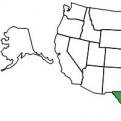
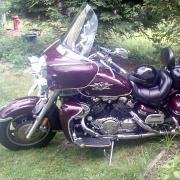


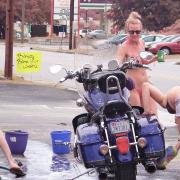
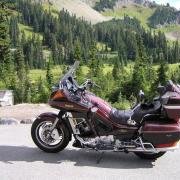
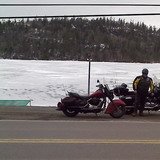


.thumb.jpg.ce61bc94739efc1059157f86c7216f78.jpg)


